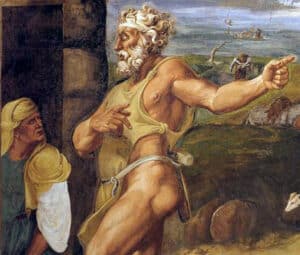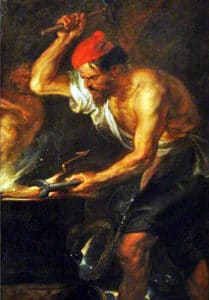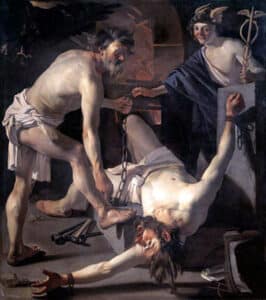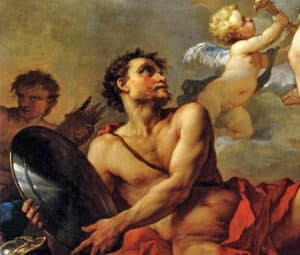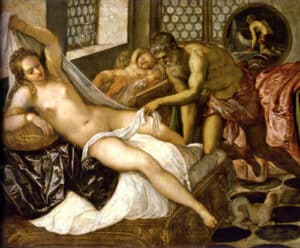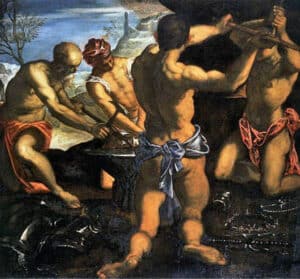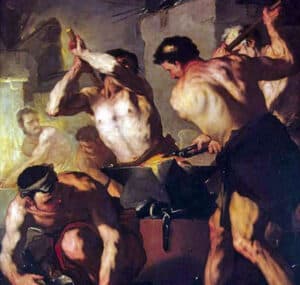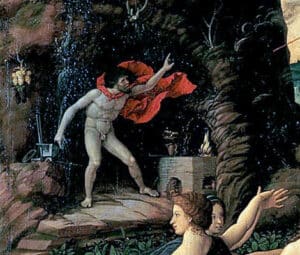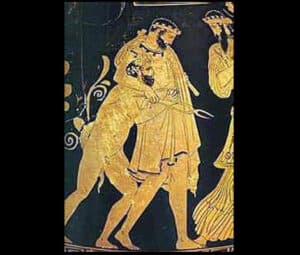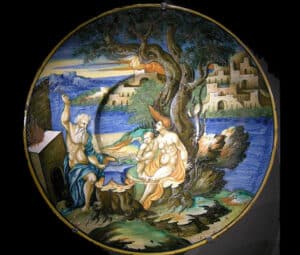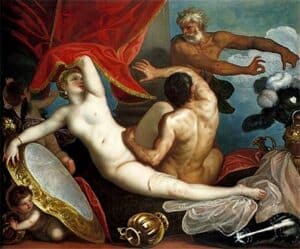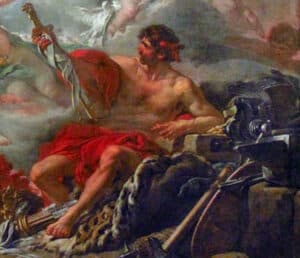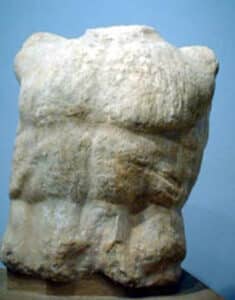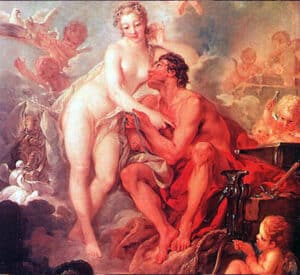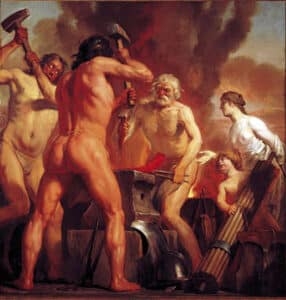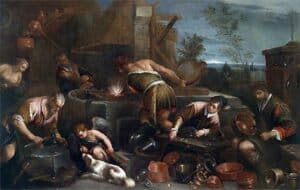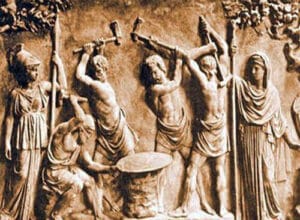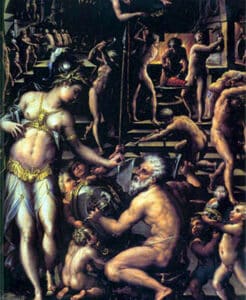Hephaestus, the God of Fire, Crafts, Smiths, and Metallurgy, is a very important God in the Greek Pantheon, despite not being as well-known as his siblings. He was a brilliant God and an excellent blacksmith. He is also associated with volcanoes because his workshops were located beneath them. Different from all the other gods, he was the only non-perfect god, having a crippled foot. His prominent symbols were the hammer, the anvil, and the tongs.
Key Facts
Family tree
| Parents | Zeus and Hera, or Hera alone |
| Partner(s) | Aphrodite, Aglaea, Gaea |
| Siblings | Aphrodite, Apollo, Ares, Artemis, Athena, Dionysus, Hermes, Aeacus, Angelos, Eileithyia, Enyo, Eris, Ersa, Hebe, Helen of Troy, Heracles, Minos, Pandia, Persephone, Perseus, Rhadamanthus, the Charites, the Horae, the Litae, the Muses,and the Moirai |
| Offspring | Immortal: Eucleia, Eupheme, Euthenia, Cabeiri, and Cabeirides, Palikoi, Philophrosyne, Thaleia Mortal: Ardalus, Cacus, Caecalus, Cercyon, Erichthonius or Erechtheus, Olenus, Palaimonios, Periphetes, Philammon, Philottos, Pylius, Rhadamanthys, Servius Tullius, Spinther |
Names & Others
| Roman Name | Vulcan |
| Other Names | Aetnaean, Khalkeus, Polymetis |
| Ancient Greek | Ἥφαιστος |
| The God of | Fire, Smiths and Crafters, Metallurgy, Volcanoes |
| Symbols | Hammer, Anvil, Tongs |
Name and Etymology
The name Hephaestus reveals the linking of the God with volcanoes, as the greek word for volcano is «ηφαίστειον» (haphaistion). It seems that the name is theophoric, meaning a name that shows what the god is “the god of”. The name is also linked with the Linear B a-pa-i-ti-jo, further showing that Hephaestus is actually a theophoric name.
A common epithet of Hephaestus was Aitnaios (Aetnaean) because he built his workshop under mount Aetna in Sicily. Other common epithets, describing his attributes were Amphigyeeis (crippled on both sides) and Kyllopodion (the one with dragging feet). Many epithets were used to describe his brilliance and his work, like Khalkeus (coppersmith), Polymetis (resourceful) and Polyphron (inventive) as well as Klytotekhnes (famous artificer).
The Egyptians affiliated him with Ptah and the Romans with Vulcan. There is not a direct link with a Norse God, but since many dwarves in Norse mythology were blacksmiths, he could be linked with Brokkr.
Hephaestus’ Origins and Family
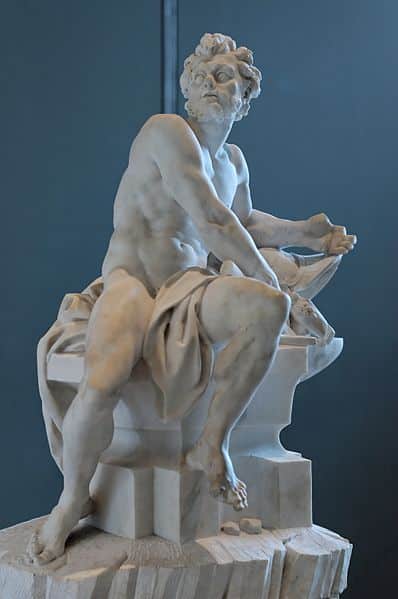
The Hephaestus family story is a textbook example of childhood trauma. He was the son of Zeus and Hera, according to Homer. Hesiod, in his great work the Theogony, says Hera gave birth to Hephaestus through parthenogenesis. According to Hesiod, Hera gave birth to Hephaestus on her own to retaliate against Zeus, who had previously given birth to the goddess Athena in the same manner.
He was either born crippled or cast to earth by Zeus or Hera, resulting in hurting one or both of his legs. His exile was prompted by his deformity and the inability of his divine parents to accept him for it.
Hephaestus’ origins are most likely Pre-Greek, stemming from an earlier time when kings should be skilled in crafting and metalwork. His crippling could represent the harsh working conditions of blacksmiths.
Hephaestus’ Lovers
Hephaestus was one of the few Gods who didn’t leave a trail of broken hearts (or, more accurately, helpless mortals) behind him. He was best known for his failed marriage to Aphrodite, his later marriage to Aglaea, as well as his accidental impregnation of Gaia. There were a few other relationships that we will mention briefly.
Hephaestus’ Marriage to Aphrodite
There are numerous myths surrounding Aphrodite and Hephaestus’ marriage. It is possible that Aphrodite was given to him as a gift because Zeus wanted to save Hera from the wrath of her son after he wanted to take revenge on his mother. In another version of the story, Zeus sent Aphrodite to marry Hephaestus, the ugliest of the Gods, because all the other Gods were fighting over her.
Whatever the truth is, Aphrodite and Hephaestus married despite Aphrodite’s adulterous affair with Ares. Helios, the sun god, informed the smith God of Aphrodite and Ares’ affair one day. Hephaestus subsequently devised a plan to catch them in the act: a golden net that would ensnare the couple on the bed. The plan was to humiliate them in front of the other Gods. The plan worked, and thus laughter could be heard throughout Olympus. Poseidon, the god of the sea was the only one who felt sorry for them, so he bribed Hephaestus to let them go. Ares fled to Thrace, while Aphrodite fled to Cyprus with the Charites (Graces), The epitome of charm and beauty.
Hephaestus’ Marriage to Aglaea
According to Hesiod and Homer, after his divorce from Aphrodite, he married Aglaea, the youngest of the Charites. Aphrodite appears to be with Ares in the Iliad, while Hephaestus appears to be with Aglaea. Aglaea gave birth to many of his children.
Hephaestus and the Athena – Gaia Triangle
The story of Hephaestus’ accidental impregnation of Gaia, the goddess of the Earth, is quite interesting. One day, Athena went to his workshop to commission some weapons. Hephaestus, who had recently been abandoned by Aphrodite, threw himself upon Athena. Even though he tried to force himself on her, the goddess refused to let him. His sperm, however, landed on her leg. Athena, disgusted, wiped it and threw it on the ground. Gaia was thus accidentally impregnated and Erichthonius was born. It is said that the first Athenians were born as a result.
Other Love Affairs
Little is known about the god’s other love affairs. Before Persephone married Hades, Hephaestus, Ares, Hermes, and Apollo all tried to woo her.
Hephaestus also had a relationship with two nymphs: Aetna, the nymph of Mount Etna in Sicily, where God had his workshop, and Cabeiro, a Lemnian sea nymph.
There are a few stories about his encounters with mortal women. He had erotic affairs with Anticleia, Atthis, and Ocresia, all of whom later gave birth to his children.
Hephaestus’ Offspring
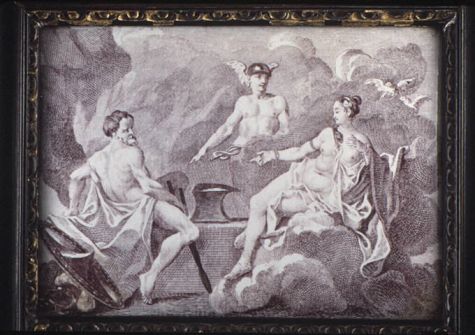
Hephaestus had a few mortal and immortal children. He had fewer children than the majority of gods and goddesses. The most intriguing fact however is that he had no children with his first wife, Aphrodite. Let’s see the list of all his children.
Immortal Children
Most of Hephaestus’ children were born by Aglaea. The children of Hephaestus and Aglaea are:
- Eukleia, the goddess of good reputation and glory
- Eupheme, the goddess of praise and triumph
- Euthenia, the goddess of abundance and prosperity
- Philophrosyne, the goddess of kindness and friendliness
Hephaestus and the nymph Aetna also had children: Thaleia, a Sicilian nymph (not to be confused with the Muse), and the Palici, Sicilian chthonic deities of geysers and hot springs.
Furthermore, Cabeiri, the enigmatic Samothrace chthonic deities, are the sons of Hephaestus and the nymph Cabeiro. They were identified with the crab and, like their father, were physically disabled. Cabeirides, the Nymphs, Guardians of Nature of the Mysteries of Samothrace, were also their children.
Mortal Children
Erysichthon, also known as Erechtheus, and Periphetes were two of Hephaestus’ most famous mortal sons. Erichthonius was the first Athenian, born when the God’s sperm fell to the ground following his failed attempt to mate with the goddess Athena. He was an early Attic king and the founder of the Athens polis.
Hephaestus and Anticlea had a son named Periphetes. He was a well-known bandit who lived in Epidaurus and hit bystanders with an iron club. Eventually, Periphetes was killed by Theseus, The Founding Hero Of Athens.
Hephaestus was also the father of:
- Ardalus, the inventor of the flute
- Cacus, a giant who was breathing fire and was killed by Heracles
- Caecalus, a king of Prainestes
- Cercyon, an Eleusinian bandit who killed passersby and was defeated by Theseus
- Olenus, an Achaian king
- Palaemonius, an Achaian lord and one of the Argonauts
- Philammon, a king and musician in Phokis (possibly the son of Apollo)
- Philottos
- Pylios, a Lemnian who cured Philoktetes after he was bitten by a snake
- Rhadamanthys, a Cretan lawmaker and judge who became the judge of the Underworld
- Servius Tullius, a king of Latium and Rome, son of Ocresia
- Spinther
Hephaestus depiction and Characteristics
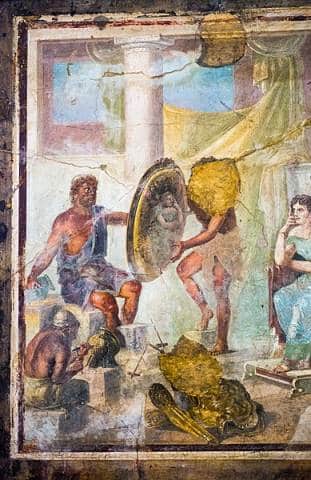
Hephaestus was distinct from the other Gods. He was well-known for being lame on one or both sides and for being ugly. The crippled God was a skilled and brilliant craftsman who oversaw the creation of all the Olympians’ weapons.
Hephaestus’ Appearance
Hephaestus was born deformed. He was portrayed as a middle-aged man with black curls, a beard, and broad shoulders who was extremely muscular, most likely due to his manual labor. The God dressed in sleeveless tunics and a hair cap. We don’t know much about his disability, but he had to have a limb in one or both of his legs.
Even if his disability is ignored, Homer emphasizes Hephaestus’ bad looks in the Iliad. He gave him a “hairy back” and a “massive neck” in his portrayal. Both characteristics were contrary to what the ancient Greeks considered to be a standard of male beauty.
Hephaestus’ Personality
Contrary to popular belief, Hephaestus was a very kind and faithful God who was literally thrown out of Olympus by his own mother because of his appearance. He was both loving and lovable, and he was adored by both humans and gods.
Hephaestus was the most peaceful and friendly God, as well as the most hardworking. He was a brilliant craftsman who built, created, and gave to all Gods. Because of how the other Gods treated him since his birth, the darkest aspects of his personality were jealousy and bitterness.
Hephaestus’ Powers
Hephaestus was an all-powerful God. He was immortal, had superhuman strength and stamina, his senses were enhanced, and he was invulnerable and omnipresent, just like the other Olympians.
In addition, he possessed the ability to give life to inanimate objects. He was credited with inventing the first automatons. As the God of Fire, he could withstand heat without being burned while also transforming himself into the fire at any time.
But his main strength was his work. That was his great power, being a blacksmith and a craftsman to the Gods. Because his weapons were indestructible, he created all weapons for Gods.
Hephaestus’ Sacred Symbols
Hephaestus’ sacred symbols were also his working tools. His sacred symbols were his hammer, anvil, and tongs, the tools of his trade. His sacred estate also included forges on Lemnos, Olympus, Volcanus, and by the river Oceanos, which encircled the entire Earth.
Hephaestus’ Sacred Animals / Plants
Hephaestus, as a God of smithing and labor, had few sacred animals and plants. However, the crane, donkey, and guard dogs were seen as his sacred animals. The crane had been Hephaestus’ sacred bird since he lived on the banks of the river Oceanus, where the bird migrated every winter. Its head was commonly depicted in the donkey saddle or chariot of Hephaestus.
Because the God is frequently depicted riding a donkey, the donkey was also associated with him. Finally, his Aetna temple had a pack of sacred dogs, so he is associated with guard dogs.
The fennel was the only plant considered sacred by Hephaestus because of its slow-burning stalk, which was used as a torch.
Hephaestus’ Roles and Responsibilities
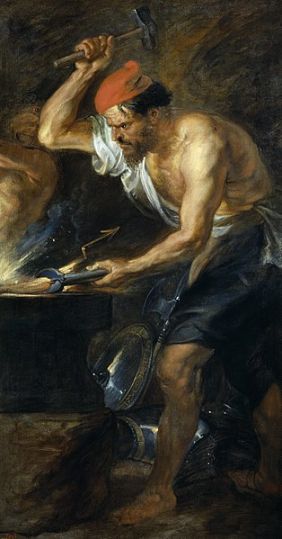
Hephaestus was a master craftsman. His name was used to denote the element of fire because he was the god of fire. He created many of the Gods’ crafts and weapons as a craftsman, including Zeus’ scepter, Hermes’ helmet, Hera’s locking doors, Achilles’ shield, and so on. His job was to design military equipment for the Gods. Hephaestus’ sole responsibility could be said to be his craft.
Military Crafts
Hephaestus was a master of crafts. Other than the crafts for the Gods, he also created military equipment. He is credited with having created:
- The aigis (breastplate) of Zeus
- The armor and shield of Achilles and Heracles
- The armor of Aeneas
- The arrows of Apollo and Artemis
- The adamantine knife of Perseus
- The spear and knife of Peleus
- Weapons for Cabeiri
Automata
Homer also mentions an intriguing fact: Hephaestus was the first God to create automata. He had created golden handmaidens for his forges who possessed intelligence (like enhanced robots with AI) and helped him with his work. He also sculpted gold dogs to guard Alcinous’ palace, as well as Talos, the bronze giant who guarded the island of Crete.
Hephaestus also fashioned a pair of gold and silver watchdogs and golden bulls for Aeetes’ palace, as directed by Aetees’ father, Helios. Moving on, it is said that he also created Pandora, The First Woman, the first human woman.
Architectural Works
In addition, Hephaestus was a fantastic architect. He had built all the palaces for the Olympians and the Sun God, Helios, with each God’s needs in mind, such as the locking doors in Hera’s chamber. He had also given the Gods all of their golden thrones. However his mother Hera received a special gift. Hephaestus crafted a cursed adamantine throne which locked Hera to it when she sat down on it. This is said to have later forced Zeus to marry off Aphrodite to please Hephaestus.
Hephaestus also built palaces for some notorious mortals, including Alcinous and Aeetes.
Miscellaneous Works
Hephaestus had also created many other different objects:
- Chariots of Gods (Helios, Cabeiri, Ares, Aphrodite)
- Jewelry of the Gods
- Crowns of Ariadne and Pandora
- Wine-Bowls (Menelaos, Achilles, The Mightiest Champion of The Trojan War, Priamos, Evenus, Telephos)
- Chains of Ares and Aphrodite
- Chains of Prometheus, The Titan Who Defied Zeus (and possibly the eagle that ate his liver)
- Rattles of Heracles
Try your skills with the hephaestus game
After everything you have learned about Hephaestus, do you dare to test your knowledge in this game?
You can also play around with Hepheastus’ and other Olympian gods’ names in this fun anagram game:
Finished? Why don’t you try our other games?
Myths About Hephaestus
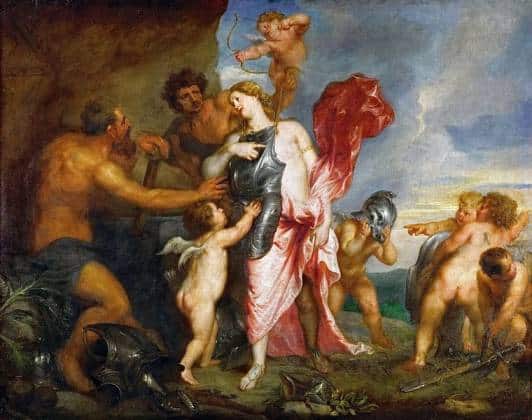
The majority of the myths surrounding Hephaestus’ life do not revolve around happy events. The harsh myth of his birth, exile, as well as vengeance on his mother is the most infamous myth surrounding the God. Also, the myth of his wife’s adulterous affair with a more charismatic God, with whom she was apparently in love.
Birth, Exile, Return , revenge
According to Hesiod, after Zeus gave birth to Athena on his own, Hera later did the same to Hephaestus out of jealousy. However, he was born deformed, which was something that the “perfect” Olympians could not stand. As a result, his mother, Hera, threw him from Olympus.
He was gravely wounded when he fell on the island of Lemnos, and he was injured on his legs as a result of that fall. He was then rescued by Thetis and Eurynome, who raised him in a cave beneath the ocean.
When Hephaestus reached adulthood, he resolved to return to Olympus and exact revenge on his mother. He made a throne for Hera when he was creating the Gods’ thrones. She was immediately bound with invisible cords when she sat on the throne.
Many Gods offered him a place on Olympus in exchange for letting her go. According to the myth however, he only agreed after Zeus promised him Aphrodite’s hand in marriage or after Dionysus made him drunk.
The Trojan War
Hephaestus played an important role in the Trojan War. He was a calming voice in a Zeus-Hera argument over Thetis, a sea nymph, assisting the Gods in cooperating. He also fashions weapons and armor for many heroes, including Achilles. Finally, the god is credited with convincing the river god Scamander not to kill Achilles after the hero insulted him.
Aphrodites’s Affair And Harmonia
Hephaestus was enraged by Aphrodite’s affair with Ares and soon sought vengeance. His vengeance was exacted on Aphrodite and Ares’ daughter, Harmonia, as a result. One day he presented Harmonia with a necklace that was to create a curse that would later follow Harmonia’s descendants. Subsequently, that led all the way up to the infamous Oedipus, The Tragic Hero Who Solved the Riddle but Couldn’t Unravel His Fate, who was cursed to kill his own father and marry his mother without his knowledge.
Hephaestus Favors
Hephaestus, as a loving God, favored many mortals. For instance, king Oinopion blinded Orion, The Celestial Hunter, the infamous hunter-giant, on the island of Chios. Hephaestus then assisted the giant by sending his servant Hedallion to guide Orion to the sun-God Helios and save him by restoring his sight.
The smith God also helped king Pelops by purifying him of his crime, after the king killed Myrtillos, the son of God Hermes.
Hephaestus in Ancient Greek Religion
He was a well-liked God in Greek religion. He was widely worshiped, particularly alongside the goddess Athena. Because he was associated with the triumph of civilization over chaos, he shared temples with the goddess of wisdom. Evidently, they were working together, with Athena representing the spirit and knowledge and Hephaestus representing the material and dexterity. Both Gods collaborated to help gods and mortals improve their skills.
Sites Sacred to Hephaestus
The Temple of Hephaestus near the Ancient Agora in Athens, Greece, is the most prominent of the temples. It is well-preserved and visible throughout the Theseum area. Also, the whole island of Lemnos was dedicated to the God, and there was also a town called Hephaestia.
There is also little information about an altar for the god in Olympia, Elis.
Worship & Festivals
The Chalkeia was a bronze workers’ festival dedicated to Athena and Hephaestus. It was celebrated late in the autumn, on the last day of Pyanepsion. Both gods were revered as patrons of crafts and the city of Athens.
There is also information on the orphics’ celebration of the autumnal equinox. As well as the celebration that marked Persephone’s descent to the Underworld to live with Hades. There is also information about the celebration of fire and Hephaestus.
Representations in Art
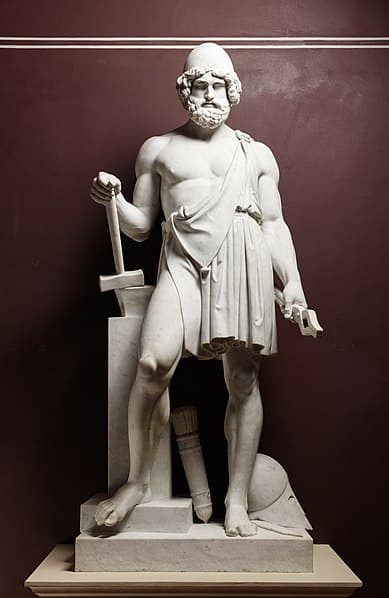
Hephaestus was frequently depicted as a deformed figure, which translated as a hunchback or a clubbed foot. In some depictions, he is portrayed riding his donkey or holding a cane because he is unable to walk. Moreover, he appears to be a muscular middle-aged man with a beard.
In contrast to the myth in which he is born by Hera after the birth of Athena, Hephaestus appears in sculptures and vases assisting Zeus with the birth of Athena. In many paintings, he can be seen crafting the armor of Achilles or Aeneas, the Trojan hero. For example, the painting “Venus at the Forge of Vulcan” (1757) by François Boucher depicts Aphrodite asking Hephaestus to make Aeneas’ armor.
In The Old Texts
Hepheastus is a character who appears frequently in Greek and Roman literature. He appears most prominently in the works of Hesiod and Homer. Hesiod’s Theogony contains much information about God’s genealogy and state, whereas Homer’s Iliad contains much information about Hephaestus’ craftsmanship and loving nature.
Ovid and Virgil also provide information on Hephaestus’s dealing with his wife’s adulterous affair with Ares, as well as Harmonia’s curse.
FAQs
Hephaestus was the god of fire, crafts, metallurgy, and smiths.
Zeus and Hera, however one version holds that it was Hera alone.
Hephaestus was first married to Aphrodite, who cheated on him with Ares. Later he was married to Aglaea as well.
He designed military equipment for both gods and mortal heroes. However, Hephaestus’ most impressive work is most likely his automata.
While there is no direct equivalent, he is better associated with Brokkr.
Sources
Aeschylus
- Agamemnon 281 ff
Hesiod
- Theogony 864
Homer
- Odyssey 8.267, 24.71
- Iliad 18.136, 23.33
- Homeric Hymn 20 to Hephaestus
Nonnus
- Dionysiaca 5.88
Ovid
- Metamorphoses 4.170
Pausanias
- Description of Greece 1.14.6, 3.18.13, 5.14.6
Plato
- Laws, 920d
Pseudo-Apollodorus
- Bibliotheca 3.187
Virgil
- Aeneid 8.372
Featured Image Credit: Wellcome Images, CC BY 4.0, via Wikimedia Commons

